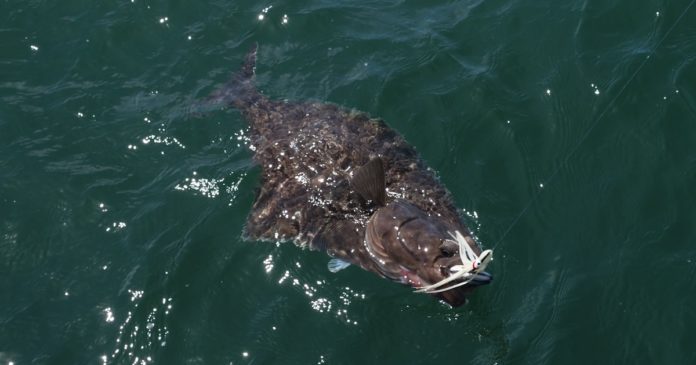To be frank, anchoring is dangerous unless practiced with extreme care and attention to safety. If you are new to halibut anchoring, I strongly recommend you go with a friend who is very experienced and have them “show you the ropes,” so to speak, or hire a guide and let them know you want to learn how to anchor safely. Most reputable guides will be more than happy to turn a charter into a teaching session.

Halibut Anchor Setup
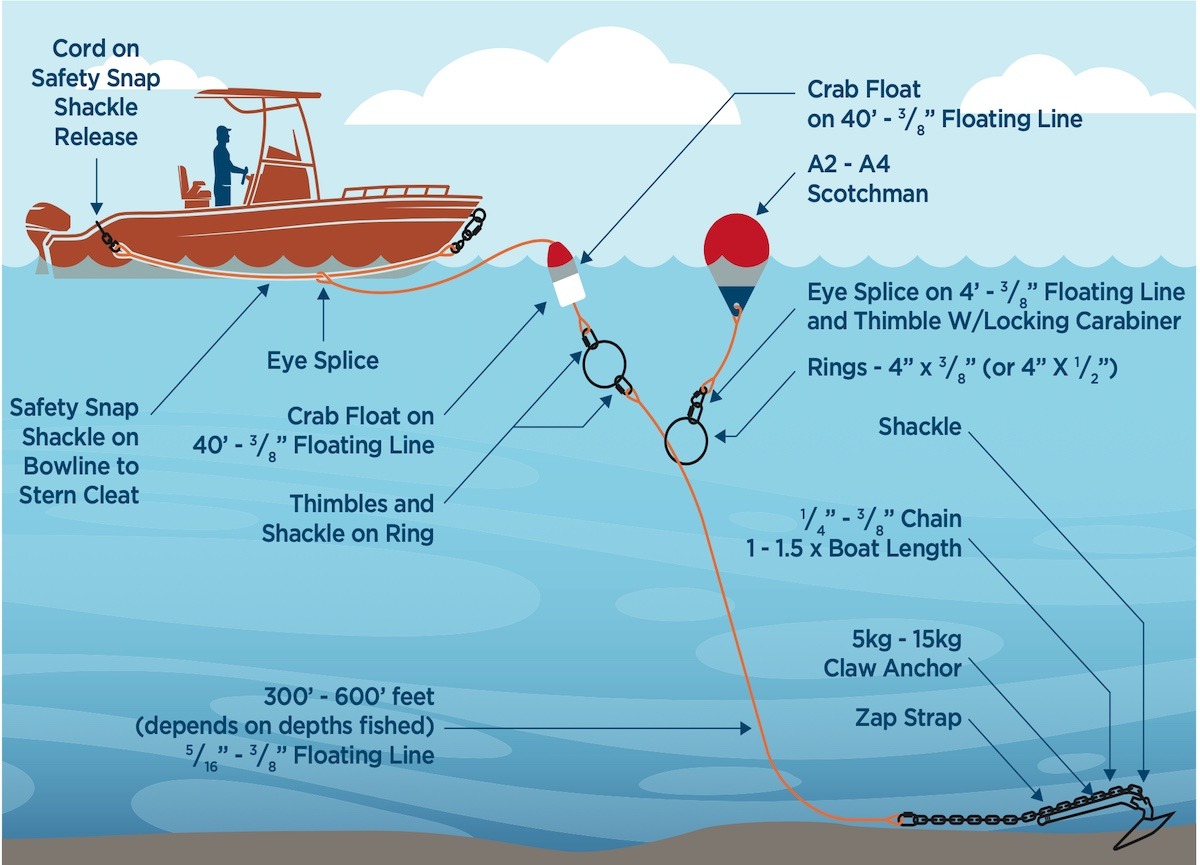
There are several anchoring systems available. If you are considering purchasing an anchor system, there are a number of reputable retail suppliers on Vancouver Island. We can’t cover them all, so I’ll focus on the system I prefer, which employs a bow rope that you run from your bow trailering eye back to either midships or a stern corner. Attach a 3″ stainless ring to the stern end of the bow line—this will be used to attach a quick, release clip which will allow you to quickly release the anchor system in an emergency. The anchor boat attachment end will have a small loop or 6″ stainless ring which allows the anchor to be attached to the bow line.
Quick Release

In the event of an emergency, the quick release can be deployed, and the anchor line will simply slip off the bow line. It is important that the bow line isn’t long enough to tangle in your engines once released, as it will drop into the water.
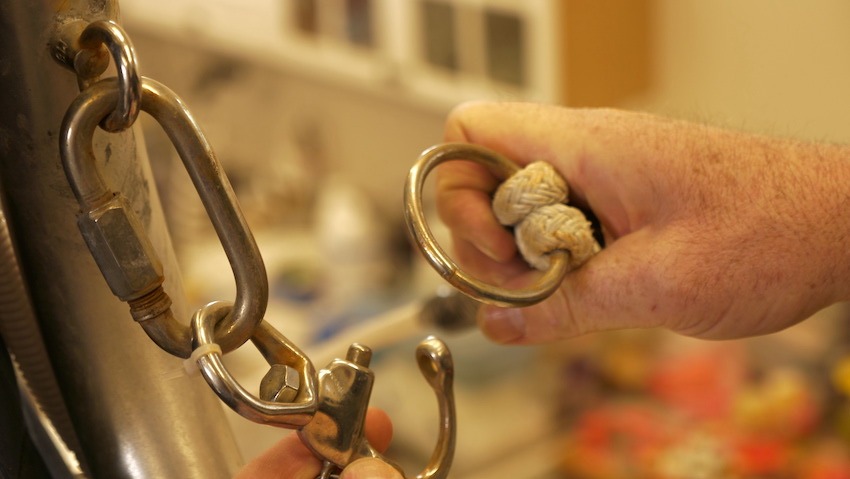
The boat end of the anchor rope has a 30′ to 50′ line that runs to a 6″ stainless ring. The actual anchor rope is attached to this ring. The purpose behind the short line between your bow line and the Scotchman buoy is to have the line between the boat and the buoy pulling along the top of the water rather than pulling down your bow in heavier seas, causing the bow to dip into waves—a dangerous situation. The ring serves as a stop for the anchor when it is pulled up. This ring is also where you attach your large 2′ to 3′ diameter Scotchman buoy.
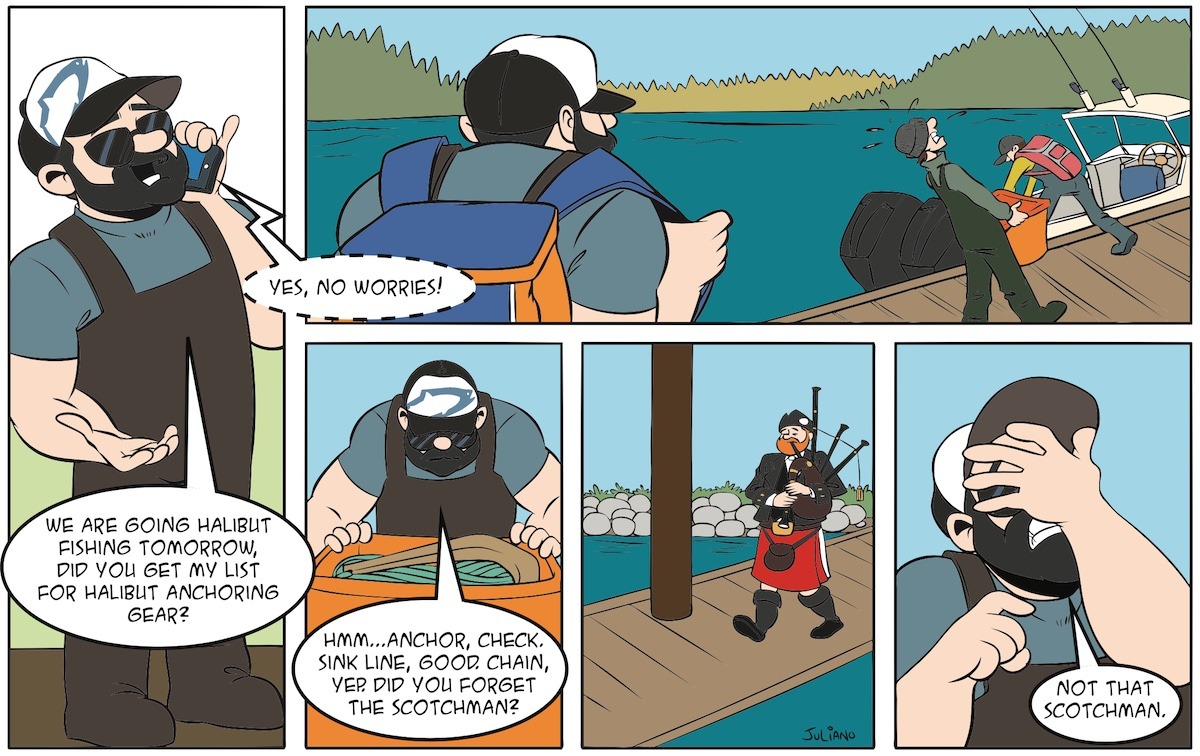
Scotchman Buoy
I run a 4′ rope from the Scotchman down to a locking carabiner that allows me to attach the buoy to the stainless ring. The purpose of this setup is to allow the anchor rope to pass through the ring when you deploy the anchor, and later it will act to allow you to use the boat to power pull the anchor up through the ring.
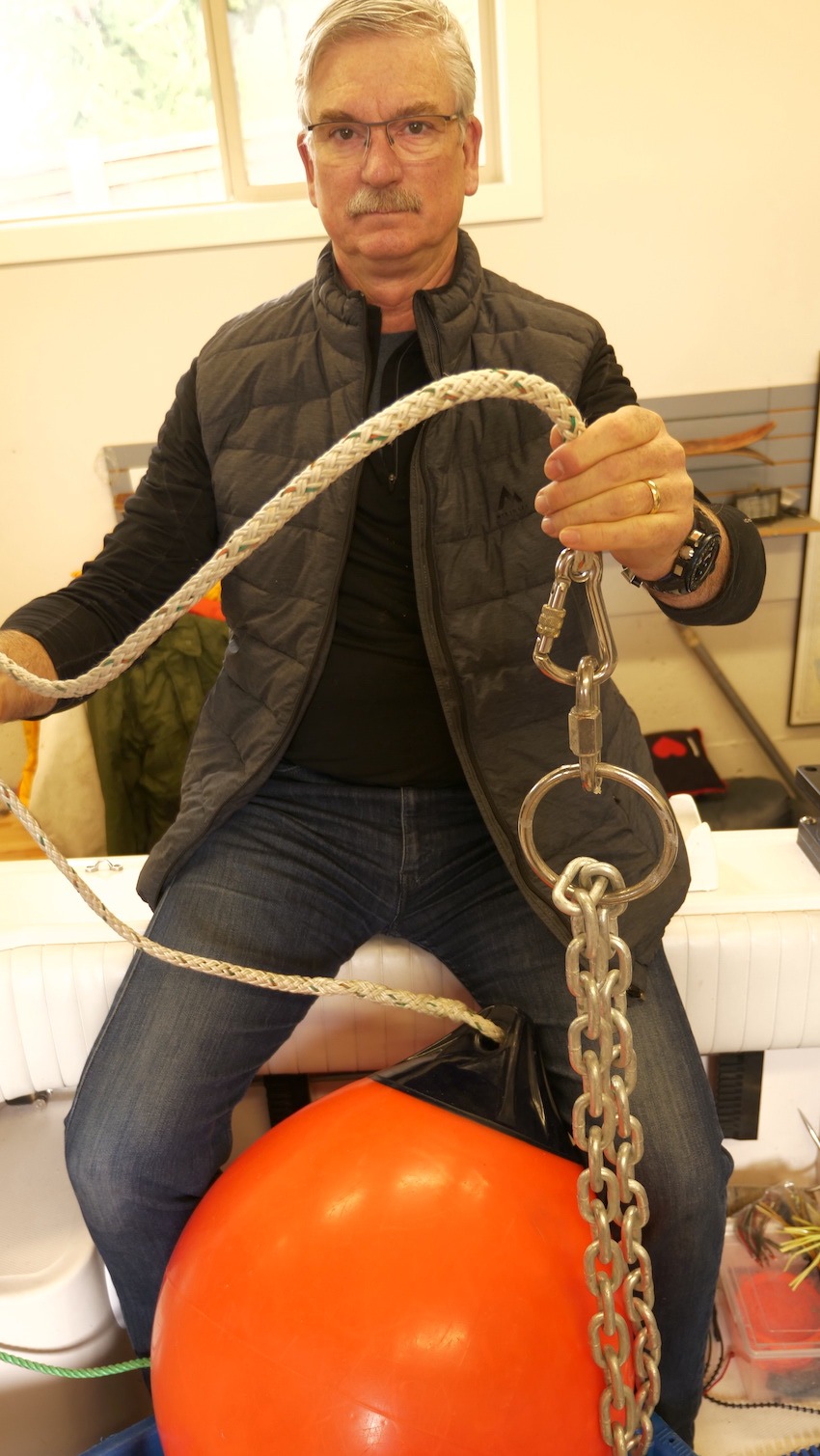
The length of anchor rope you use will depend on depths fished. To allow sufficient scope for the anchor to grab, you will need enough rope to reach the bottom, plus at least 25% to 30% more rope to allow for the scope. It is also important to have a length of chain between the anchor and your rope end that is around 1 to 2 times as long as your boat. As you choose your anchor chain, consider the weight of your boat. The more weight and/or the stronger current you plan to anchor in, the longer your chain and heavier the anchor required.
At minimum, the anchor chain must be heavier than the actual anchor, otherwise it will slip to the bottom once it is pulled up through the retrieval ring. So once the anchor is pulled up, the chain will hang below the Scotchman buoy holding up the anchor. All that is needed then is to carefully pull in the anchor rope, coiling it into a bin.
Anchor Bin
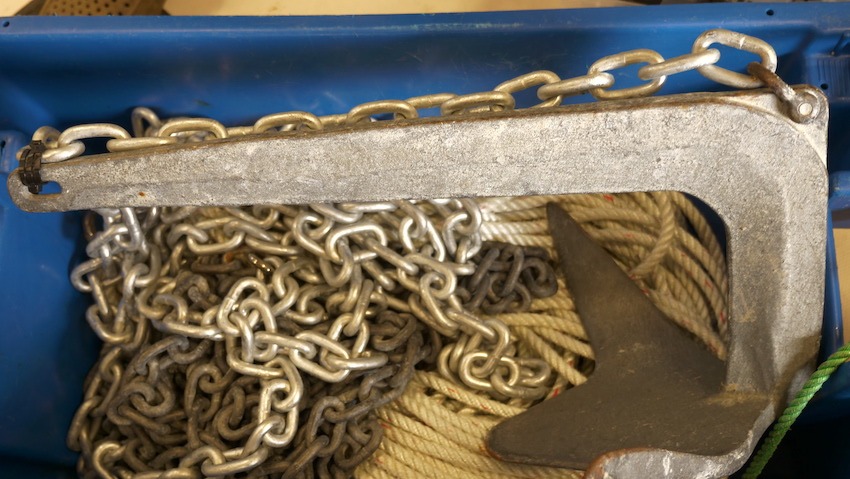
My preferred anchor type is the Bruce or claw anchor. You attach the anchor chain to the front eye of the anchor and then lay the chain along the length of the anchor, attaching it with 4 strong zap straps. In the event the anchor becomes lodged in the bottom, you can pull the anchor in a different direction and more easily dislodge it.
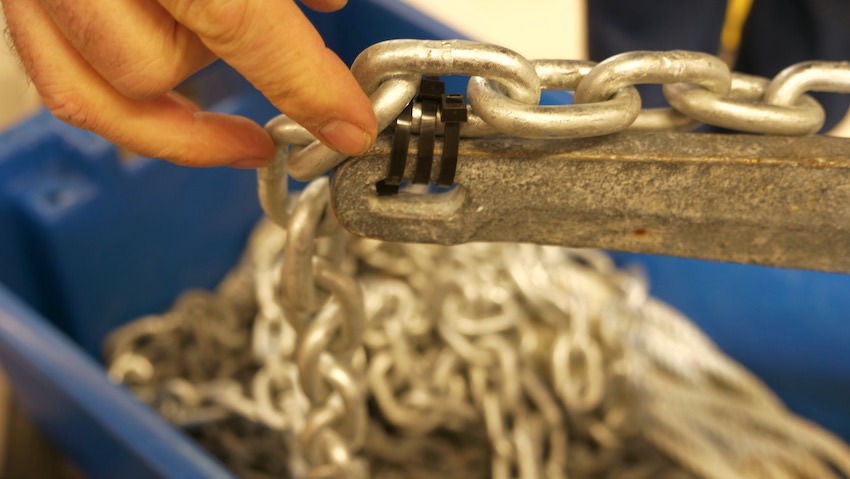
Weather Conditions and Current for Halibut Anchoring
As a general rule, I don’t recommend anchoring in waves much over a metre. Also, if the wave period (time and/or distance between waves) is too short, choppy conditions can really make setting or retrieving anchors challenging.
Strong currents can also add to tension on your vessel while at anchor. Smaller vessels can be whipped around in heavy currents, and even have their bows of the boat pulled downward, creating a danger of capsizing. Avoid anchoring in heavy currents unless you have a larger vessel and sufficient experience to accurately identify a dangerous situation. When it doesn’t feel safe, the best approach is not to anchor, or to pull up your anchor. If things change rapidly for the worse, another option is to simply detach, leave the anchor, and come back for it another day.
Deploying the Halibut Anchor

Before dropping anchor, always stop and let the vessel settle into the current and wind to help you to assess the direction, speed, and effects of how the boat will drift. Place the vessel in a position where it will drift away from where the anchor is dropped—and make sure the rope will pay out in a direction away from the drift and your engines! Avoid situations where the rope pays out under the boat, as this could result in serious risk of tangling the rope in your engines or possibly capsizing the vessel.
Before deploying the anchor, connect the boat-end loop of the anchor to the bow line, and also connect the Scotchman to the 6″ ring. When preparing to drop the anchor, ask someone on the vessel to hold the ring and Scotchman while you slowly lower the anchor rope to the bottom. Once the anchor is on bottom, pay out the remaining anchor rope, then toss the Scotchman over the side. I prefer to then move the boat carefully away from the Scotchman and anchor using my kicker to avoid tangling in the rope. Then back down in the direction of the current and wind, positioning the Scotchman buoy ahead of the bow of your boat.
Once the anchor is safely deployed, spend a few minutes to watch how the current sets up. If you notice the boat starts drifting back towards or passing the Scotchman, you may need to use the kicker to reposition the boat in a way that helps align it to the current drift, preventing the boat from crossing up on the anchor.
Only when you are satisfied the vessel has stabilized on anchor is it safe to start fishing.
Another consideration is maintaining a careful watch for large commercial vessels. Commercial vessels have the right of way in most situations; even if they don’t, as a small vessel owner you are not exactly in a position to negotiate right of way. I always have my AIS on to allow me to track vessels from a long distance and plot their course. If it appears they could be on a track that intercepts where we are anchored, it’s always safest to pull up the gear and prepare to either unhook from your anchor and move off until the danger passes or pull the anchor. The advantage of the bow rope anchor system is you can unhook, go do some salmon fishing, and return later to reconnect and resume halibut fishing (click here for my halibut tips article).
Avoid anchoring in the fog, because it becomes increasingly challenging to watch radar, track AIS, and determine the track of incoming vessels of any size. If you do anchor in these conditions, be hypervigilant.
Have a safety plan and explain to everyone on board how you will detach from the anchor in the case of an emergency. During an emergency is no time to attempt to explain to your passengers how to deal with the anchor.
Retrieving (Pulling) the Halibut Anchor

Pulling the anchor is simple. Start the main engine and slowly advance the boat forward at about a 30° to 45° angle to one side of the Scotchman buoy. Carefully position the boat to not tangle with the rope, but to allow the section of rope between the bow and Scotchman to come alongside slowly. Have a passenger grab the rope with a gaff hook, then tie the rope to a rear deck cleat. Once the rope is attached securely to the deck cleat, you can then carefully use the boat power to move forward past the Scotchman buoy, which then allows the anchor rope to be pulled through the 6″ ring below your Scotchman pulling up the anchor. Pull long enough to ensure the entire length of the anchor rope and chain has passed through the ring under the Scotchman. You often will see the Scotchman start bouncing once the anchor is fully retrieved. Stop the boat and slowly pull in the rope, coiling it into a bin or bucket for safekeeping. Once the entire anchor system is in the boat, detach the loop end of the anchor rope from the quick release and bow rope to stow away the gear.
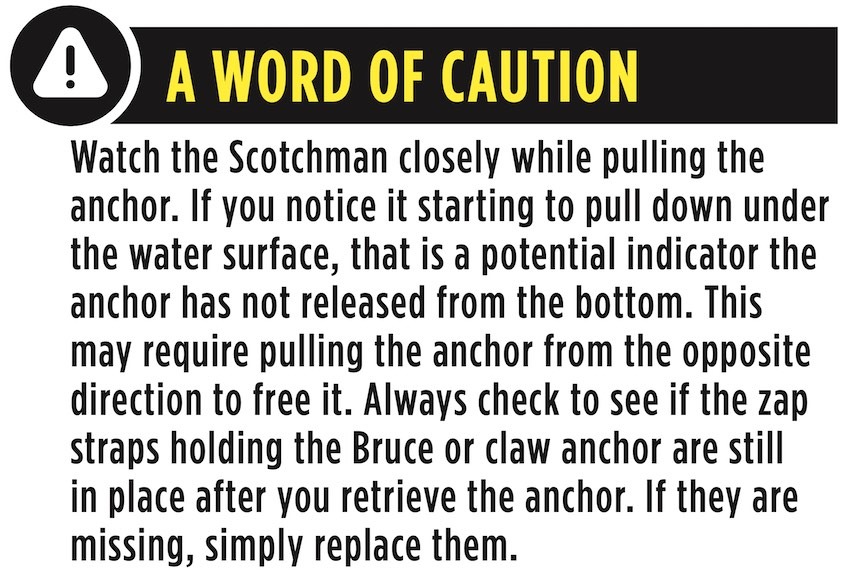
This article appeared in Island Fisherman magazine. Never miss another issue—subscribe today!


